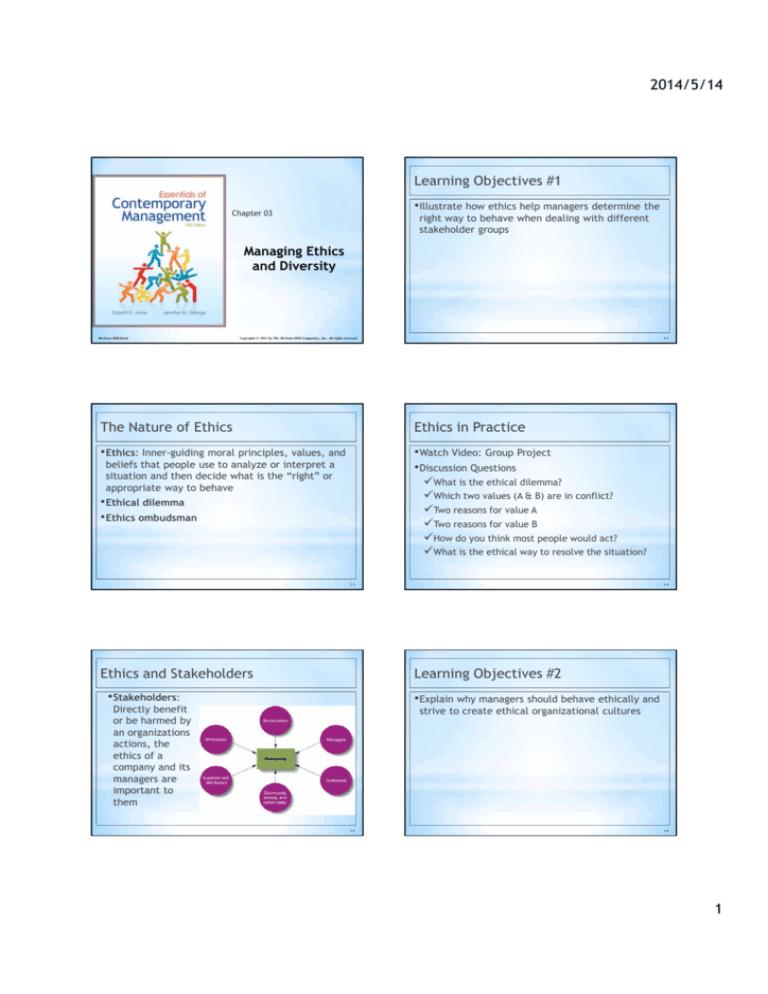
2014/5/14
Learning Objectives #1
•
Illustrate how ethics help managers determine the
Chapter 03
right way to behave when dealing with different
stakeholder groups
Managing Ethics
and Diversity
McGraw-Hill/Irwin
Copyright © 2013 by The McGraw-Hill Companies, Inc. All rights reserved.
3-2
The Nature of Ethics
Ethics in Practice
•
Ethics: Inner-guiding moral principles, values, and
•
Watch Video: Group Project
•
Discussion Questions
beliefs that people use to analyze or interpret a
s
i
t
uat
i
onandt
hendeci
dewhati
st
he“r
i
g
ht
”or
appropriate way to behave
What is the ethical dilemma?
Which two values (A & B) are in conflict?
Two reasons for value A
Two reasons for value B
How do you think most people would act?
What is the ethical way to resolve the situation?
•
Ethical dilemma
•
Ethics ombudsman
3-3
Ethics and Stakeholders
3-4
Learning Objectives #2
•
Stakeholders:
•
Explain why managers should behave ethically and
Directly benefit
or be harmed by
an organizations
actions, the
ethics of a
company and its
managers are
important to
them
strive to create ethical organizational cultures
3-5
3-6
1
2014/5/14
Why Should Managers Behave Ethically?
Four Ethical Rules
•
The relentless pursuit of self-interest can lead to a
collective disaster if individuals start to profit from
being unethical, encouraging other people to act in
the same way
3-7
S
our
c
esofOr
gani
z
at
i
on’
sCodeof
Ethics
3-8
Learning Objectives #3
•
Appreciate the increasing diversity of the
workforce and of the organization environment
3-9
Diversity of the Workforce and the
Environment
•
Diversity: Differences among people in age, gender,
3-10
Sources of Diversity in the Workplace
race, ethnicity, religion, sexual orientation,
socioeconomic background, and
capabilities/disabilities
•
Glass ceiling: Metaphor alluding to the invisible
barriers that prevent minorities and women from
being promoted to top corporate positions
3-11
3-12
2
2014/5/14
Learning Objectives #4
Critical Managerial Roles
•
Grasp the central role that managers play in the
•
Managers have more influence than rank-and-file
effective management of diversity
employees
•
When managers commit to diversity, it legitimizes
diversity management efforts of others
3-13
3-14
Effectively Managing Diversity Makes
Good Business Sense
•
Diverse organizational members can be a source of
Learning Objectives #5
•
Understand why the effective management of
diversity is both an ethical and a business
imperative
competitive advantage when managed efficiently
•
Variety of points of view and approaches to
problems and opportunities that diverse employees
provide can improve managerial decision makin
3-15
3-16
Learning Objectives #6
Forms of Sexual Harassment
•
Understand the two major forms of sexual
•
Quid pro quo: Asking or forcing an employee to
harassment and how they can be eliminated
perform sexual favors in exchange for some reward
or to avoid negative consequences
•
Hostile work environment: Telling lewd jokes,
displaying pornography, making sexually oriented
r
emar
ksabouts
omeone’
sper
s
onalappear
anc
e,and
other sex-related actions that make the work
environment unpleasant
3-17
3-18
3










